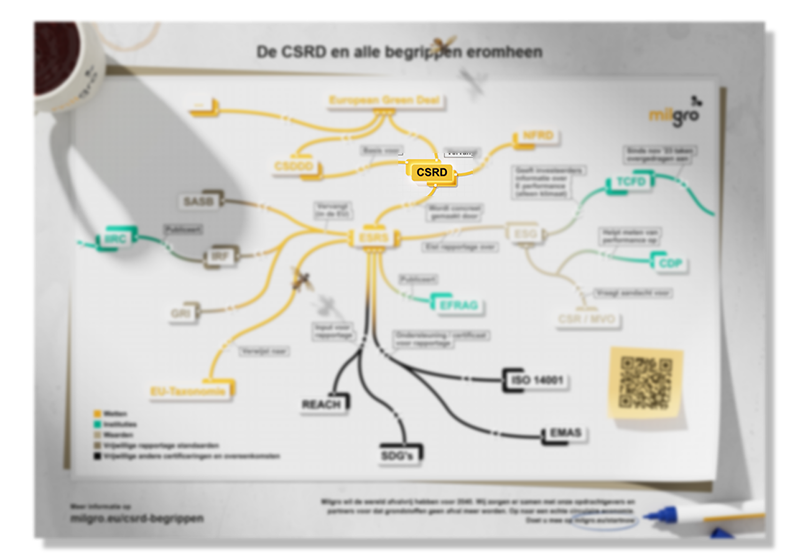The European Union wants to be climate neutral by 2050 and is working on an economy that is less dependent on primary raw materials. Circularity plays an important role in this: by keeping materials longer in the chain, we reduce CO₂ emissions and reduce dependence on new raw materials.
To accelerate the transition to a circular economy, the EU is increasingly introducing new laws and regulations. Think of stricter requirements for reporting, packaging and disposable plastic. In this blog you can read what exactly circularity means, which laws and regulations are important and what they mean for your business.
What is circularity?
Circularity is the opposite of the linear model. In a linear model, raw materials are discarded after use. As a result, valuable materials are lost and pressure on scarce natural resources, such as metals and minerals, increases.
Circularity revolves around use rather than consumption. Materials stay in circulation as long as possible through reuse, repair and recycling. The result: less waste and less resource loss.
Why is circularity important?
Every year, we consume more raw materials than the earth can replenish in that same year. For example, Earth Overshoot Day in 2025 already fell on July 24. As of that moment, we use more resources than the earth can replenish in that year. This leads to scarcity, loss of valuable materials and high CO2 emissions. Circularity offers a solution: by designing, producing and processing smarter, we prevent waste and make our economy more resilient.
In addition, circularity offers opportunities for new business models. Reusing materials, offering products as services and extending life cycles create economic value. According to research by the Ellen MacArthur Foundation, a circular economy could generate hundreds of billions of euros for Europe by 2030.
Legislation that accelerates circularity: CSRD, ESRS, SUP, PPWR and more
Companies see government as a partner in shaping circular policies. This is according to research by Milgro among 311 Dutch and Belgian companies. For 32% of the organization, government measures play a major role in determining their circular ambitions.
An important example of legislation developed by the European Union to accelerate the transition to a circular economy is the Corporate Sustainability Reporting Directive (CSRD). This requires large companies to report on their sustainability ambitions, including waste streams and resource use. These are companies that meet two of the following criteria: more than 250 employees, more than 40 million euros in turnover and more than 20 million euros in total assets.
Reporting for the CSRD is done according to the European Sustainability Reporting Standards (ESRS), which specifies exactly what information must be disclosed.
A recent EU decision ("stop-the-clock") moved the first reporting year for some organizations to fiscal year 2027, with publication in 2028. This is especially true for companies that originally would not be covered by the CSRD until later, such as large unlisted companies and listed SMEs. It gives them extra time to prepare and put their reporting systems in order. Large listed companies-which meet two of the aforementioned criteria-are still required to report for reporting year 2024.
CSRD and the circular economy
Mandatory reporting helps companies better understand their material flows, waste production and recycling. They must not only provide figures, but also present plans for reducing waste and encouraging reuse and recycling. This insight makes it easier to formulate circular improvement opportunities and targets and make circularity progress measurable.
Packaging and Packaging Waste Regulation (PPWR).
The Packaging and Packaging Waste Regulation (PPWR) is a new European regulation aimed at making the packaging chain circular. The legislation officially came into force Feb. 11, 2025, but companies have until Aug. 12, 2026, to prepare before most of the obligations take effect. The PPWR requires manufacturers and importers to make packaging more sustainable: less material use, a higher proportion of recycled plastic and clear separation information on packaging.
Does your organization need help preparing for the PPWR? Throughout the year, we conduct online webinars. Check our event page for upcoming sessions or follow the webinar on demand, at a time that suits you.
Green Claims Directive: European law against greenwashing
The Green Claims Directive is a European Commission proposal from March 2023 that imposes stricter rules on companies that use sustainability claims in their communications. The goal? To protect consumers from misleading information and combat Greenwashing.
Specifically, this means that companies may only use sustainability claims such as ''100% recyclable'' or ''climate neutral'' if they:
- are scientifically substantiated with objective data, for example by a life cycle analysis;
- have been independently verified before publication by an external party that verifies that the substantiation is correct.
In addition, companies must make the information available transparently, for example through a QR code on the product packaging.
The directive will become part of the broader European sustainability strategy (the EU Green Deal), which also includes legislation such as the CSRD (Corporate Sustainability Reporting Directive) and the Ecodesign for Sustainable Products Regulation (ESPR).
Ecodesign for Sustainable Products Regulation (ESPR).
The (ESPR)is a regulation, which means it is directly applicable in all EU member states. This regulation focuses on improving the sustainability of products through eco-design. The goal? To make products more durable, energy efficient and easier to recycle. Consider using recycled materials, reducing harmful substances and improving the repairability of products.
The ESPR came into force on July 18, 2024, and applies to all companies that make products placed on the EU market. Companies must ensure that their products meet the new ecodesign requirements to remain on the market.
Single Use Plastics (SUP) Directive.
In June 2019, the Single Use Plastic (SUP) Directive was adopted. This is a European law against the production and use of Single Use Plastics. The goal is to reduce the impact of single-use plastics on the environment. The law came into effect July 3, 2021. Over the years, more and more rules are being added to the SUP Directive. Examples of these rules include:
- As of July 1, 2021, deposits on plastic bottles will apply.
- As of Jan. 1, 2022, fishermen must collect a minimum of 23% of their fishing gear waste. This percentage will be increased annually, as fish waste accounts for as much as a quarter of plastic waste in the sea.
- By July 1, 2024, caps must be attached to plastic bottles and beverage containers.
Taking action yourself
A quarter of companies believe that organizations that do not invest in sustainability in the near future will disappear. And although laws and regulations can encourage companies to accelerate the transition towards a circular economy, it is important that companies also continue to take steps themselves.
Managing Director Gijs Derks of Milgro states: "As long as companies and government continue to point at each other, the circular transition will not get off the ground. Many organizations want to, but get stuck on unclear rules and lack of financial incentives. The government must create clear frameworks, but taking the first circular steps is and remains the responsibility of the organizations themselves. Those who continue to wait for perfect policies will remain stagnant''.
How do you become truly circular as a company?
To give direction to that, we have developed a concrete step-by-step plan that you can apply immediately. This will help your organization to:
- Gain insight into where you are as an organization;
- Take concrete, applicable steps - whether you are a starter or more advanced;
- Reduce waste through smarter design, sustainable procurement and better collaboration in the supply chain.
Stay informed
Want to stay up to date with the latest developments? Follow us on LinkedIn and Instagram or subscribe to our newsletter. Curious about what Milgro can do for your operations and waste process? Feel free to get in touch .

















